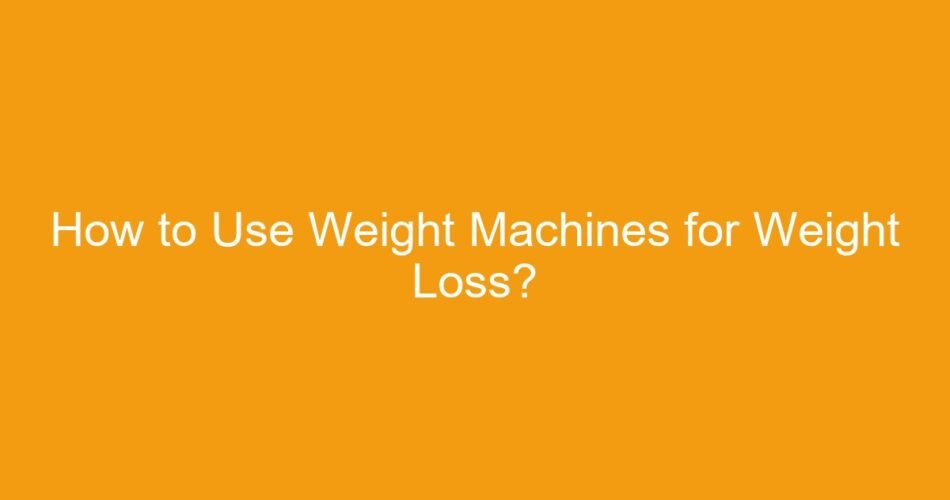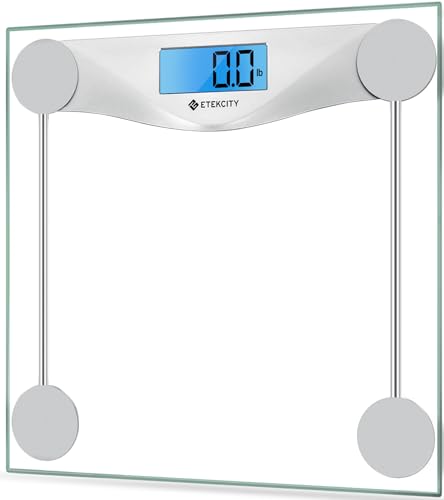How to Use Weight Machines for Weight Loss?
To effectively address the question of How to Use Weight Machines for Weight Loss, the strategy relies on using structured resistance to build muscle, boosting your resting metabolism, and accelerating overall calorie expenditure for faster results.
Using weight machines for weight loss requires shifting your focus from maximizing one-rep maximums to maximizing metabolic demand and increasing lean muscle mass. The effectiveness of using resistance machines for fat loss is tied directly to the principle of creating a consistent calorie deficit while preserving muscle tissue during that deficit. This guide outlines the precise training parameters needed to leverage gym equipment efficiently for sustainable body composition change.
🛒 Recommended Product
The Weight Loss Mechanism: Why Resistance Training is Essential
While cardio directly burns more calories during the workout, resistance training on machines provides a crucial, long-term metabolic advantage that cardio alone cannot match. To understand how to use weight machines for weight loss, you must embrace the concept of muscle preservation.
Muscle is Metabolically Expensive
Muscle tissue burns significantly more calories at rest than fat tissue does. The primary goal of a weight loss program utilizing resistance machines should be to send a signal to your body to retain muscle mass, or even build new muscle, while you are dieting. This increase in lean mass directly elevates your Basal Metabolic Rate (BMR), ensuring you burn more calories every hour, every day, even when sleeping.
The EPOC Effect
Resistance training also activates a significant Excess Post-Exercise Oxygen Consumption (EPOC) effect. This “afterburn” means your body continues to expend elevated amounts of energy repairing muscle fibers for up to 48 hours after a strenuous session. Machines allow trainees to push muscles to fatigue safely, maximizing this post-workout calorie burn far beyond what a steady-state cardio session achieves. According to extensive research compiled since the early 2000s, high-intensity resistance training consistently demonstrates superior EPOC benefits compared to moderate exercise.
Structuring Your Machine Workout for Fat Loss
The parameters for using weight machines to achieve weight loss differ significantly from those used for pure strength building (e.g., powerlifting). The focus must shift toward higher volume, less rest, and full-body recruitment to maximize heart rate and metabolic fatigue.
To use weight machines for weight loss, aim for metabolic resistance training (MRT), which often incorporates circuit formats:
| Parameter | Goal for Strength/Power | Goal for Weight Loss/Fat Burning |
|---|---|---|
| Weight Load | Heavy (75%–90% of 1RM) | Moderate (50%–70% of 1RM) |
| Repetitions | Low (3–6 reps) | High (8–15 reps) |
| Rest Periods | Long (2–5 minutes) | Short (30–60 seconds) |
| Frequency | Split routines (1–2 body parts per session) | Full-body or upper/lower splits (3–4 sessions per week) |
Key Workout Steps
- Prioritize Compound Movements: Use machines that engage multiple large muscle groups simultaneously, such as the leg press, seated row, lat pulldown, chest press, and shoulder press. These movements generate the highest metabolic demand.
- Maintain High Repetition Ranges (8–15): This range is optimal for inducing muscular hypertrophy (growth) and maximizing the time the muscle is under tension, leading to greater energy expenditure.
- Use Short, Timed Rest: Crucially, keep rest periods between sets and exercises short (30–60 seconds). This keeps the heart rate elevated throughout the session, blending cardiovascular conditioning with muscle development.
- Incorporate Supersets or Circuits: Move immediately from one machine exercise to another targeting an opposing muscle group (e.g., Leg Extension followed immediately by Seated Hamstring Curl) before resting. This is the most efficient way to maintain a high-intensity level necessary for fat oxidation.
Essential Weight Machine Strategy: Progressive Overload and Nutrition
Training intensity and technique are vital, but successful body composition change relies on two critical external factors: Progressive Overload and Dietary Control.
🛒 Recommended Product
Mastering Progressive Overload on Machines
The human body adapts quickly. If you perform the same workout with the same weight for six weeks, your body stops being challenged, and fat loss plateaus. Progressive overload requires gradually increasing the stress placed on the body.
For weight loss training using machines, progressive overload is best achieved by:
- Increasing the weight: Add 5–10 lbs once you can comfortably hit the upper range (15 reps).
- Increasing the volume: Add one additional set to each exercise.
- Reducing rest time: Drop rest periods by 5–10 seconds.
- Improving form: Slow down the eccentric (lowering) phase of the lift, increasing time under tension.
The Role of Calorie Deficit
No matter how structured your resistance training is, weight loss cannot occur without a calorie deficit. According to foundational nutritional science established over the last century, to lose one pound of body fat, a deficit of approximately 3,500 calories is required.
Using weight machines for weight loss is effective because the resulting muscle growth ensures that when you restrict calories, the majority of the weight lost comes from fat stores, rather than valuable muscle tissue. Focusing on adequate protein intake (typically 0.7 to 1.0 grams per pound of body weight) while training is necessary to support the recovery and muscle growth achieved by the resistance machines.
Why Weight Machines are Ideal for Beginners
While free weights (barbells, dumbbells) are excellent tools, weight machines offer specific benefits that make them superior for individuals beginning their weight loss journey:
- Safety and Form Consistency: Machines guide the movement pattern, significantly reducing the risk of improper form and injury, which is critical when training close to failure (as required in MRT).
- Isolation and Targeting: Machines efficiently isolate specific muscles, ensuring that the targeted muscle groups fatigue fully, maximizing the metabolic stress on those large muscle centers.
- Quick Adjustments: Changing the resistance level is fast and easy on machines, facilitating the rapid transitions required during circuit training and supersets without wasting critical rest time.
To truly maximize your efforts when asking how to use weight machines for weight loss, consistency is paramount. Aim for 3 to 4 resistance training sessions per week, focusing on full-body engagement during each session.
🛒 Recommended Product
Successful weight loss using machine training is fundamentally a blend of high-intensity resistance and focused nutrition. By structuring your workouts for high metabolic demand (higher reps, short rest) while maintaining a strategic calorie deficit, you will leverage muscle growth to create a sustained, highly effective fat-burning environment.
Scientific References & Research
The following peer-reviewed research papers provide additional scientific context:
-
GG Haff (2000).
Roundtable discussion: machines versus free weights
[External Link] -
N Schott et al. (2019).
Effects of free weights and machine training on muscular strength in high-functioning older adults
[External Link] -
PP González et al. (2021).
[HTML] Comparison of the Efficacy of Three Types of Strength Training: Body, Weight Training Machines and Free Weights
[External Link]
Note: External research links are provided for educational purposes and do not necessarily represent endorsement.
Frequently Asked Questions About How to Use Weight Machines for Weight Loss?
Q. What is the optimal frequency and duration for using weight machines for weight loss results?
A. Aim for 3 to 4 resistance training sessions per week, ensuring you hit all major muscle groups either through full-body workouts or a split routine. Each session should last approximately 30 to 45 minutes, focusing on compound movements and maintaining high intensity to maximize calorie burn and muscle stimulation. Ensure you incorporate rest days between intense sessions to allow for muscle recovery and prevent overtraining.
Q. Should I prioritize high reps/low weight or low reps/high weight on weight machines when focused on weight loss?
A. For weight loss and muscular endurance, a moderate approach is generally most effective: aim for 3 sets of 8 to 12 repetitions using a weight that makes the final few reps challenging but maintainable with good form. This range maximizes the metabolic stress necessary for muscle building while keeping the intensity high enough to burn significant calories during the workout. Focusing solely on very low reps with maximal weight is better suited for pure strength gain, not weight loss optimization.
Q. How important is proper form on weight machines to ensure safety and maximize weight loss effectiveness?
A. Proper form is critically important because it ensures the targeted muscles are effectively engaged, maximizing muscle development and metabolic impact. Incorrect form not only increases the risk of injury, which halts progress, but also reduces the workout’s effectiveness by shifting the load away from the intended muscle group. Always adjust the machine settings to fit your body perfectly and perform controlled movements throughout the entire range of motion.
Q. Should weight machine training be performed before or after cardiovascular exercise for maximum weight loss benefits?
A. It is generally recommended to perform your weight machine training *before* cardiovascular exercise because resistance training requires maximum energy and focus to lift heavy weights safely and effectively. Starting with weights ensures you have the necessary energy stores (glycogen) to maximize muscle recruitment, allowing you to get the most metabolic benefit before transitioning to cardio to deplete remaining fat stores.
Q. How can I ensure I am progressively overloading my muscles using weight machines to prevent weight loss plateaus?
A. Progressive overload is essential to continually challenge your muscles and maintain weight loss momentum; this can be achieved by incrementally increasing the resistance (weight) used once you can comfortably complete the target rep range. Alternatively, you can increase the number of repetitions or sets, or slow down the eccentric (lowering) phase of the lift to increase time under tension. Regularly adjusting one of these variables prevents your body from adapting and keeps the muscle growth process active.
Related Articles
Do Weight Loss Vibration Machines Work?
Vibration machines alone are not magic diet tools Do Weight Loss Vibration Machines Work The consensus from clinical trials suggests they are effectiv…
Do Rowing Machines Help with Weight Loss?
Do Rowing Machines Help with Weight Loss? Rowing machines are an outstanding tool for significant weight loss, uniquely combining high-intensity cardi…
Do Elliptical Machines Work for Weight Loss?
Ellipticals offer a powerful, low-impact solution for achieving aggressive weight management goals. Find out exactly how many calories you can burn an…
When you purchase a product through Amazon links on EllipticalKing.com, we may earn a small commission at no extra cost to you. This helps support the site and keep our content free.




